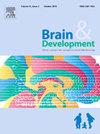Serum matrix metallopeptidase-9 levels in patients with infantile epileptic spasms syndrome before and after the initiation of vigabatrin therapy
IF 1.3
4区 医学
Q4 CLINICAL NEUROLOGY
引用次数: 0
Abstract
Purpose
Epileptic spasms are the predominant seizure type in infantile epileptic spasms syndrome (IESS). The pathophysiology of IESS, including blood–brain barrier (BBB) function involvement, remains unclear. To address this issue, we evaluated the serum matrix metallopeptidase-9 (MMP-9) and tissue inhibitor of metalloproteinase-1 (TIMP-1) levels in patients with IESS before and after initiating vigabatrin therapy.
Methods
IESS was defined as epileptic spasms occurring within 2 years after birth. We prospectively assessed serum MMP-9 and TIMP-1 levels before and after initiating vigabatrin therapy in patients with IESS who attended Saitama Children's Medical Center between February 2019 and December 2024 (n = 12; 5 boys) and compared them with those in age-matched controls (n = 14; 8 boys).
Results
The median ages at epileptic spasm onset and vigabatrin therapy initiation were 3.5 (1−11) and 8 (3−13) months, respectively. Serum MMP-9 levels were higher in patients with IESS than in the controls (p < 0.001). Serum MMP-9 and MMP-9/TIMP-1 ratios decreased significantly after vigabatrin therapy (MMP-9: 308 [160–664] ng/mL vs. 220 [112–367] ng/mL, p < 0.01; MMP-9/TIMP-1 ratio: 1.48 [0.61–8.14] vs. 1.11 [0.31–1.92], p < 0.05). MMP-9 levels decreased in 9 of 11 patients whose epileptic spasms had disappeared by the time of the last measurement.
Conclusion
Decreased MMP-9 levels after the initiation of vigabatrin therapy suggested an improvement in BBB dysfunction. Our findings shed light on the role of the BBB in IESS and the role of vigabatrin in the recovery of this function.
婴儿癫痫性痉挛综合征患者服用维加巴特林前后血清基质金属肽酶-9水平的变化
目的癫痫性痉挛是婴儿癫痫性痉挛综合征(IESS)的主要发作类型。IESS的病理生理机制,包括血脑屏障(BBB)功能受累,仍不清楚。为了解决这个问题,我们评估了IESS患者在vigabatrin治疗前后的血清基质金属肽酶-9 (MMP-9)和组织金属蛋白酶-1抑制剂(TIMP-1)水平。方法siess定义为出生后2年内发生的癫痫性痉挛。我们前瞻性地评估了2019年2月至2024年12月期间在埼玉儿童医疗中心就诊的IESS患者(n = 12, 5名男孩)在开始vigabatrin治疗前后的血清MMP-9和TIMP-1水平,并将其与年龄匹配的对照组(n = 14, 8名男孩)进行了比较。结果癫痫性痉挛发作的中位年龄为3.5(1−11)个月,vigabatrin治疗开始的中位年龄为8(3−13)个月。IESS患者血清MMP-9水平高于对照组(p < 0.001)。vigabatrin治疗后血清MMP-9和MMP-9/TIMP-1比值显著降低(MMP-9: 308 [160-664] ng/mL vs. 220 [112-367] ng/mL, p < 0.01; MMP-9/TIMP-1比值:1.48 [0.61-8.14]vs. 1.11 [0.31-1.92], p < 0.05)。在最后一次测量时癫痫痉挛消失的11例患者中,有9例MMP-9水平下降。结论维加巴特林治疗后MMP-9水平降低提示血脑屏障功能障碍改善。我们的研究结果揭示了血脑屏障在IESS中的作用,以及vigabatrin在这一功能恢复中的作用。
本文章由计算机程序翻译,如有差异,请以英文原文为准。
求助全文
约1分钟内获得全文
求助全文
来源期刊

Brain & Development
医学-临床神经学
CiteScore
3.60
自引率
0.00%
发文量
153
审稿时长
50 days
期刊介绍:
Brain and Development (ISSN 0387-7604) is the Official Journal of the Japanese Society of Child Neurology, and is aimed to promote clinical child neurology and developmental neuroscience.
The journal is devoted to publishing Review Articles, Full Length Original Papers, Case Reports and Letters to the Editor in the field of Child Neurology and related sciences. Proceedings of meetings, and professional announcements will be published at the Editor''s discretion. Letters concerning articles published in Brain and Development and other relevant issues are also welcome.
 求助内容:
求助内容: 应助结果提醒方式:
应助结果提醒方式:


